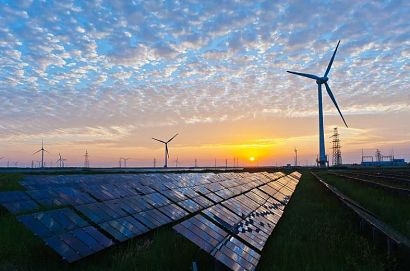
From July to September of 2022, 3.4 gigawatts (GW) of new utility-scale clean power capacity were installed, bringing 2022 year-to-date installations to 14.2 GW, according to the Clean Power Quarterly Market Report. Installations were down 22 percent compared to the third quarter of 2021, and down 18 percent year-to-date. Quarterly wind installations fell 78 percent, while solar installations dropped 23 percent. Only battery storage, which commissioned 1.2 GW this quarter, increased installations compared to the third quarter of 2021. Storage is having its best year on record, with 2022 installations already nearly even with total 2021 volumes.
Project delays weighed heavily on installation volumes as developers struggled to procure solar panels, faced supply chain challenges, and confronted ever-growing interconnection queues to connect projects to the grid. In total, 14 GW of clean power capacity was delayed this quarter, adding to a growing backlog of delayed projects that totals 36 GW – 63 percent of which are solar projects.
“While the IRA is set to catalyse clean energy growth, the industry continues to deal with policy and regulatory challenges hindering development and deployment of clean power” said JC Sandberg, Interim CEO and Chief Advocacy Officer. “The solar market has faced repeated delays as companies struggle to obtain panels as a result of an opaque and slow-moving process at US Customs and Border Protection. Policy uncertainty around tax incentives constrained wind development, underscoring the near-term need for clear guidance from the Treasury Department so the industry can deliver on the promise of the IRA. Storage was the one bright spot for the industry and had its second-best quarter on record. The aggressive deployment of storage continues to drive down consumer energy costs and enhance grid reliability.”
Overall, Texas and California had the biggest clean power deployments including large-scale wind, solar and battery hybrid developments, and standalone storage. Amazon was the largest purchaser of the quarter after announcing another 2 GW of clean power procurement in the US.
“ACP anticipates that the IRA will give industry the tools it needs to more than triple annual installations of wind, solar, and battery storage by the end of the decade” added Mr Sandberg. “We expect the IRA to deliver 550 GW of new capacity by 2030, representing $600 billion in capital investment and growing the clean power workforce to nearly a million strong by 2030. We continue to work with relevant government decision-makers to quickly resolve remaining tax guidance, supply chain, and trade challenges to realise the IRA’s full potential. This is essential to set the nation on a path to achieve its clean energy goals.”
Nearly 14.2 GW of clean power capacity were delayed this quarter, of which more than half had already experienced delays. In total, ACP is tracking 36.2 GW of delayed projects, plus a further 3.5 GW that have been terminated or cancelled.
Projects that failed to come online this quarter have an expected delay of half a year, while many have been pushed back several years. Less than half of the delayed capacity is expected online by the end of the year.
Solar dominates the clean energy project pipeline but also accounts for the majority of delayed capacity at 63 percent. Land-based wind accounts for 23 percent of delays and battery storage the remaining 14 percent.
Solar panel detentions are preventing projects from reaching completion and threaten to disrupt the pace of future installations, while supply chain disruptions and grid interconnection delays have slowed the pace of wind installations.
The 350 megawatt (MW) Azure Sky Wind Project, owned and developed by Enel in Texas, was the largest wind project to achieve operations this quarter. The 123 MW/ 189 MWh storage portion of the project is expected online by the end of the year.
The largest hybrid project commissioned this quarter was NextEra’s California-based Arlington (Riverside County Solar) Solar + Storage project, with 231 MW of solar capacity paired with 242 MW/968 MWh of battery capacity. An additional 133 MW of solar is still in development.
AES’s California Lancaster Battery Storage, at 127 MW/508 MWh, was the largest standalone storage facility online this quarter.
In total, there are now 216.4 GW of utility scale clean energy operating, powering approximately 59 million homes across the country.
Sixty five percent of that capacity is land-based wind, 32 percent solar, 4 percent battery storage, and less than 1 percent offshore wind.
Operational capacity has increased 7 percent since the start of the year.
As of the end of the quarter, there are over 132 GW of clean power capacity in development, including 39 GW under construction and 93 GW in advanced development. Between July and September, 2.5 GW of capacity began construction, and 4.6 GW entered advanced development.
Capacity entering the pipeline has been waning over the past few quarters, down 36 percent from Q2 and 40 percent from Q1.
Policy uncertainty prior to the passage of the Inflation Reduction Act has weighed on pipeline growth. With the package in place and reasonable timelines for Treasury guidance issuance, the pipeline is expected to return to rapid growth.
Amazon was the largest purchaser during the quarter after announcing another 2 GW of clean power procurement in the US.
Announcements of new contracts by clean power buyers also slowed this quarter. Buyers and developers announced 7.2 GW of new power purchase agreements (PPAs) this quarter, down 31 percent from the same period last year. Year to date, announcements are down just 3 percent compared to 2021.
Commercial and industrial (C&I) purchases account for 43 percent of announcements, and utilities an additional 25 percent.
For additional information:

